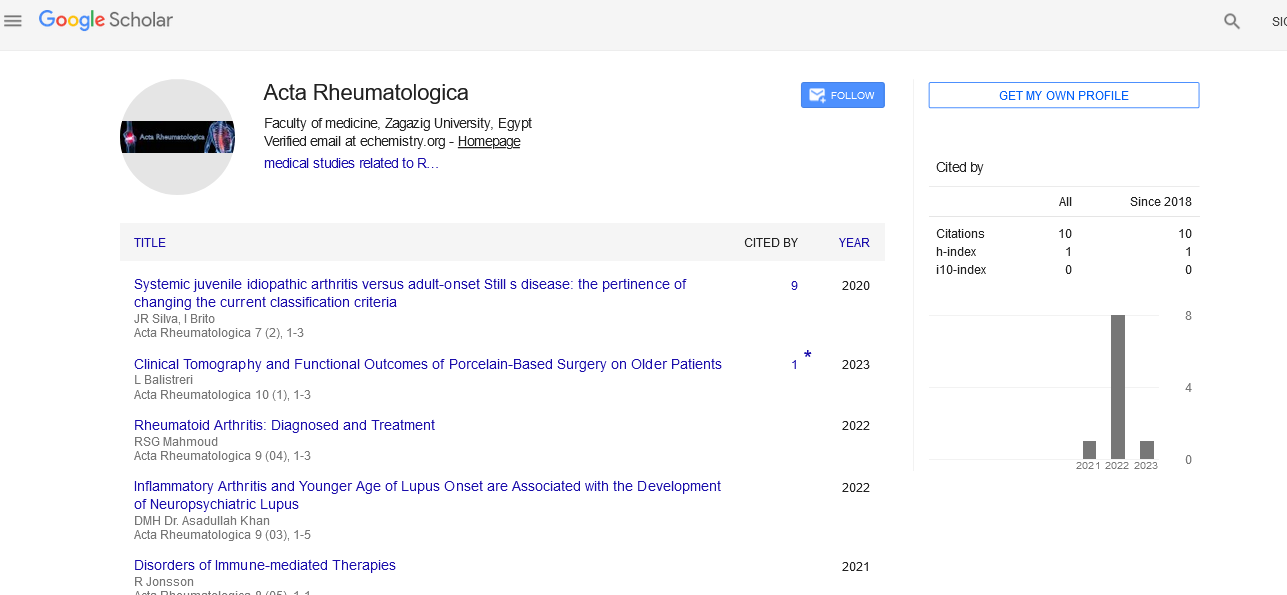Perspective - (2023) Volume 10, Issue 5
Unraveling the Art and Science of Rheumatology: Navigating the Complexities of Joint Health
Sevim Oksuz*
Department of Medical and Healthcare, Kasturba Medical College, Turkey
*Correspondence:
Sevim Oksuz, Department of Medical and Healthcare, Kasturba Medical College,
Turkey,
Email:
Received: 05-Sep-2023, Manuscript No. ipar-23-14250;
Editor assigned: 08-Sep-2023, Pre QC No. ipar-23-14250 (PQ);
Reviewed: 25-Sep-2023, QC No. ipar-23-14250;
Revised: 03-Oct-2023, Manuscript No. ipar-23-14250 (R);
Published:
11-Oct-2023
Introduction
Rheumatology, a multidimensional specialty, is akin to
solving a puzzle where the pieces constantly change shape.
It delves into the intricate world of joints, connective
tissues, autoimmune diseases, and musculoskeletal
disorders. At the heart of this field lies the rheumatologist,
a professional equipped with a diverse skill set,
compassion, and an unwavering commitment to decipher
the complexities of joint health.
Understanding the role of a rheumatologist
Rheumatologists are highly specialized physicians with
expertise in diagnosing and treating over 100 different
types of arthritis and rheumatic diseases. Their scope
encompasses conditions like rheumatoid arthritis, lupus,
osteoarthritis, gout, and an array of connective tissue
disorders. Their approach involves a comprehensive
understanding of the immune system, joints, bones,
muscles, and associated structures.
The diagnostic odyssey
Diagnosing rheumatic conditions often requires astute
clinical skills and a methodical approach. Rheumatologists
meticulously analyze a patient's medical history, perform
physical examinations, and utilize a range of diagnostic
tools like blood tests, imaging studies, and sometimes
invasive procedures like joint aspirations or biopsies. This
process is crucial to unraveling the mystery behind often
complex and diverse symptoms.
Treatment modalities
Treatment in rheumatology is multifaceted.
Rheumatologists employ various strategies tailored to
individual patients. This could involve a combination of
medication, physical therapy, lifestyle modifications, and in
some cases, surgical interventions. The advent of biologic
therapies and targeted medications has revolutionized the
landscape, offering more precise and effective treatment
options.
Description
The impact of research and technology
Continuous research and technological advancements are
pivotal in the field of rheumatology. Innovations in
understanding the genetic, environmental, and immunological aspects of rheumatic diseases have paved the way for
more personalized and effective treatments. Moreover,
technological breakthroughs in imaging and diagnostic
tools enhance early detection and better management of
these conditions.
The human aspect: Patient care and
quality of life
Beyond the science and technology, rheumatology is
fundamentally about improving the quality of life for
individuals living with chronic joint conditions.
Rheumatologists not only provide medical care but also
offer emotional support, guidance, and education to
empower patients in managing their conditions effectively.
Challenges in rheumatology
While advancements are significant, challenges persist.
Access to specialized care, rising healthcare costs, and the
complexity of certain conditions present ongoing hurdles.
Additionally, the shortage of rheumatologists in certain
regions poses a significant challenge in providing timely
and quality care to patients.
The future of rheumatology
Looking ahead, the future of rheumatology holds promise.
With ongoing research, evolving technologies, and a
growing understanding of the intricate mechanisms
underlying rheumatic diseases, there's hope for more
targeted, precise, and personalized treatments. Telemedicine
and digital health solutions also show potential in expanding
access to specialized care.
Treatment
Most rheumatic sicknesses are treated with analgesics,
NSAIDs (nonsteroidal calming drug), steroids (in serious
cases), DMARDs (illness adjusting antirheumatic drugs),
monoclonal antibodies, like infliximab and adalimumab,
the TNF inhibitor etanercept, and methotrexate for
moderate to extreme rheumatoid arthritis. The biologic
specialist rituximab (against B cell treatment) is presently
authorized for use in headstrong rheumatoid arthritis.
Physiotherapy is essential in the therapy of numerous
rheumatological messes. Word related treatment can assist
patients with finding elective ways for normal
developments that would somehow or another be
confined by their infection. Patients with rheumatoid
joint pain frequently need a long haul, composed and a
multidisciplinary group approach towards the board of
individual patients. Treatment is frequently customized
by the singular requirements of every patient which is
likewise subject to the reaction and the bearableness of
drugs. Starting during the 2000's, the fuse of
biopharmaceuticals (which incorporate inhibitors of
TNF-alpha, certain interleukins, and the JAK-Detail
flagging pathway) into guidelines of care is one of the
fundamental advancements in present day rheumatology.
Conclusion
Rheumatology stands at the intersection of art and
science. It requires a blend of medical expertise, empathy,
and an unwavering commitment to enhancing the lives of
those grappling with joint-related ailments. The journey
of a rheumatologist involves solving intricate puzzles,
advocating for patients, and embracing the constant
evolution in medical knowledge and technology. As the
field progresses, the tireless dedication of rheumatologists
remains paramount in reshaping the narrative of joint
health.





